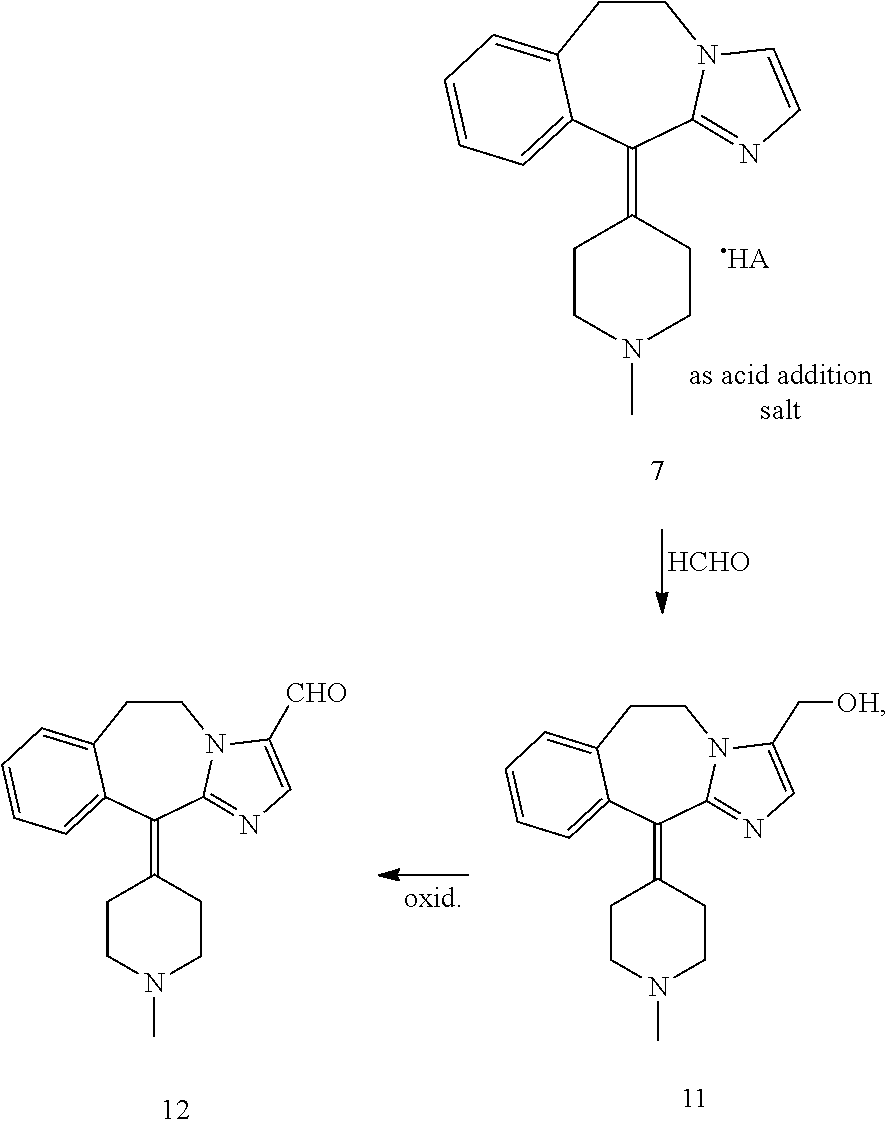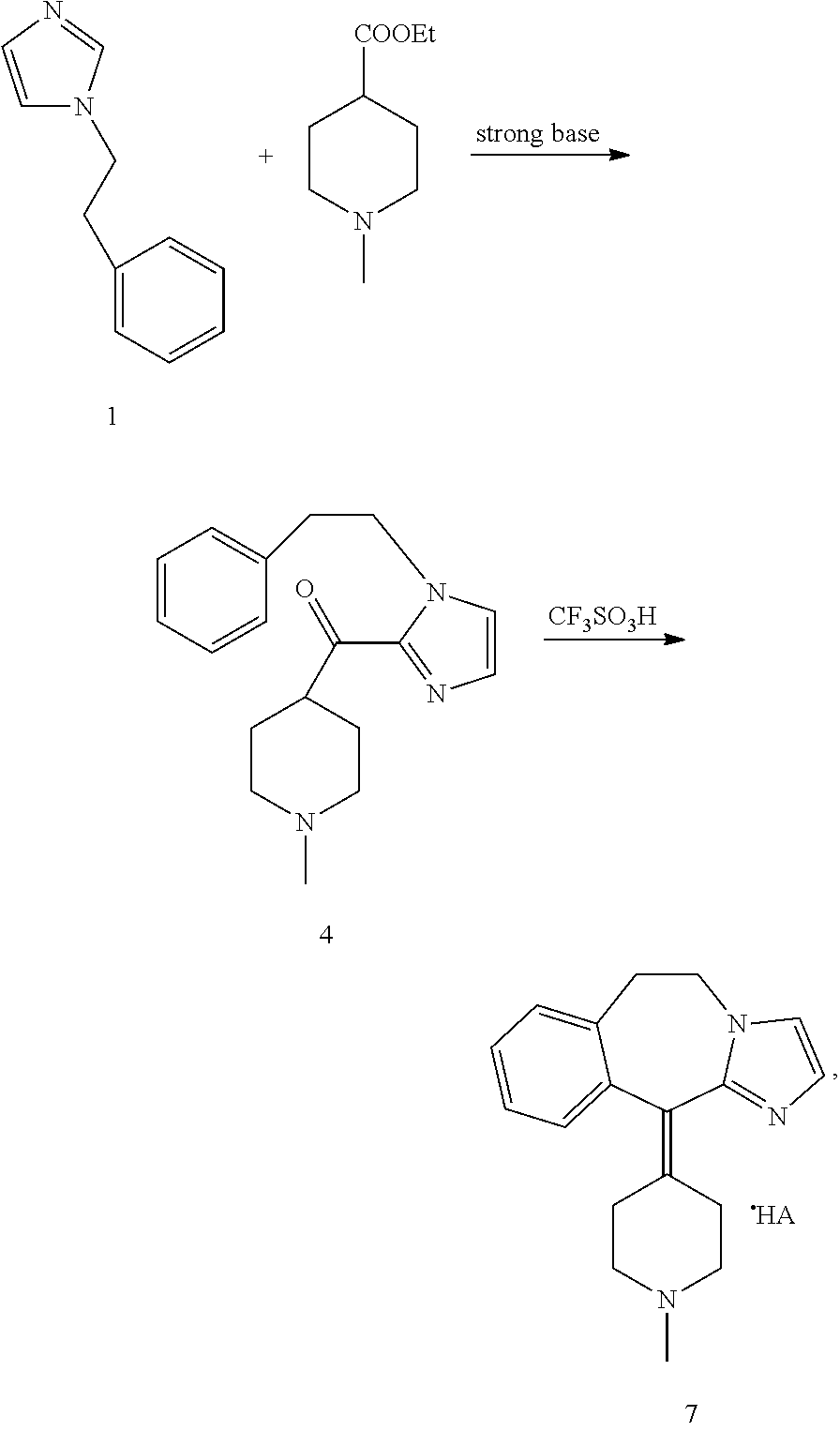Methods for the preparation of alcaftadine
- Summary
- Abstract
- Description
- Claims
- Application Information
AI Technical Summary
Benefits of technology
Problems solved by technology
Method used
Image
Examples
example 1
Preparation of [1-(2-phenylethyl)-1H-imidazol-2-yl](1-methyl-4-piperidinyl)-methanone (intermediate 4)
[0055]
[0056]N-(2-phenyl)-ethyl imidazole (20 g, 0.12 mol) was dissolved in a mixture of toluene (100 ml) and tetrahydrofuran (60 ml). The solution formed was cooled down to −50° C. and then a solution of LDA (lithium diisopropylamide) 2 M in tetrahydrofuran (128 ml, 0.26 mol) was added. The temperature was kept at −50° C. for 15 minutes and then a solution of N-methyl ethyl isonipecotate (48.1 g, 0.28 mol) in toluene (50 ml) was added. After 1 hour at −50° C. the reaction was quenched by addition of water (200 ml).
[0057]The temperature was adjusted to 20° C. and the layers were separated. The aqueous layer was extracted with toluene and the solvents were distilled to a final volume of 60 ml.
[0058]A 5-6 N solution of HCl in isopropanol (74 ml) was added followed by acetone 1200 ml. The solid formed was filtered, washed with acetone (100 ml) and dried to afford 28.5 g (74% yield) of [...
example 2
Preparation of [1-(2-phenylethyl)-1H-imidazol-2-yl](1-methyl-4-piperidinyl)-methanone (intermediate 4) as the hydrobromide salt
[0066]
[0067]N-(2-phenyl)-ethyl imidazole (7.9 g, 0.046 mol) was dissolved in a mixture of toluene (40 ml) and tetrahydrofuran (24 ml). The solution formed was cooled down to −50° C. and then a solution of hexyllithium 2.7 M in hexane (37.5 ml, 0.101 mol) was added. The temperature was kept at −50° C. for 15 minutes and then a solution of N-methyl ethyl isonipecotate (19.0 g, 0.11 mol) in toluene (20 ml) was added. After 1 hour at −50° C. the reaction was quenched by addition of water (80 ml).
[0068]The temperature was adjusted to 20° C. and the layers were separated. The aqueous layer was extracted with toluene and the solvents were distilled to a final volume of 24 ml.
[0069]A 33% solution of HBr in acetic acid (7.8 ml) was added followed by ethyl acetate (160 ml). The solid was filtered, washed with ethyl acetate (40 ml) and dried to afford 11.6 g (67% yield...
example 3
Preparation of 6,11-dihydro-11-(1-methyl-4-piperidinylidene)-5H-imidazo[2,1-b][3]-benzazepine as the fumarate salt (Intermediate 7)
[0072]
[0073]A mixture of trifluoromethanesulfonic acid (600 ml) and intermediate 4.HCl (74 g of hydrochloride salt, 0.22 mol) was heated to 95° C. for 6 hours. When the reaction was complete, the solution was cooled to 25° C. and poured into 1.5 L of cold (0 / 5° C.) water. The pH was adjusted to 9 / 10 by addition of 50% aqueous NaOH and the product was extracted with dichloromethane.
[0074]The solvent was distilled and changed to acetone and the volume was adjusted to 590 ml. Fumaric acid (25.7 g, 0.22 mol) was added and the mixture warmed to 50 / 55° C. for 1 hour. The solvent was distilled to a final volume of 295 ml. The suspension was cooled to 20° C., filtered and washed with cold acetone. After drying 60.5 g (69% yield) of 6,11-dihydro-11-(1-methyl-4-piperidinylidene)-5H-imidazo[2,1-b][3]-benzazepine (intermediate 7, fumarate salt) were obtained.
[0075]S...
PUM
 Login to View More
Login to View More Abstract
Description
Claims
Application Information
 Login to View More
Login to View More - R&D
- Intellectual Property
- Life Sciences
- Materials
- Tech Scout
- Unparalleled Data Quality
- Higher Quality Content
- 60% Fewer Hallucinations
Browse by: Latest US Patents, China's latest patents, Technical Efficacy Thesaurus, Application Domain, Technology Topic, Popular Technical Reports.
© 2025 PatSnap. All rights reserved.Legal|Privacy policy|Modern Slavery Act Transparency Statement|Sitemap|About US| Contact US: help@patsnap.com



